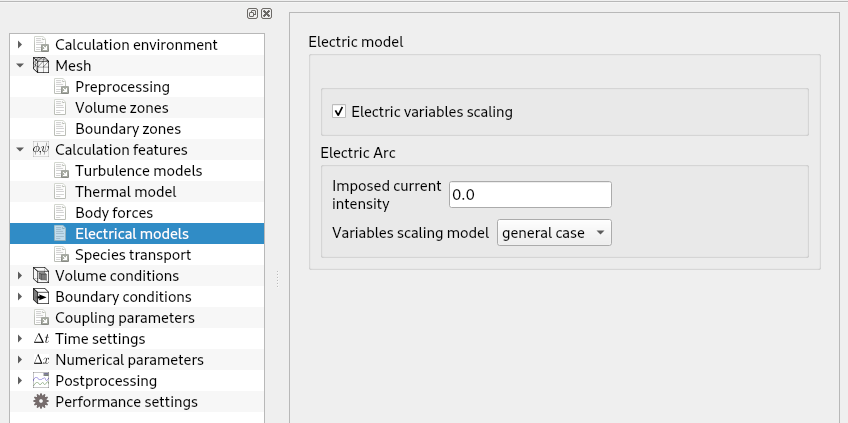The electric module is composed of a Joule effect module (CS JOULE EFFECT) and an electric arcs module (CS ELECTRIC ARCS).
The Joule effect module is designed to take into account that effect (for instance in glass furnaces) with real or complex potential in the enthalpy equation. The Laplace forces are not taken into account in the impulse momentum equation. Specific boundary conditions can be applied to account for the coupled effect of transformers (offset) in glass furnaces.
The electric arcs module is designed to take into account the Joule effect (only with real potential) in the enthalpy equation. The Laplace forces are taken into account in the impulse momentum equation.
The electric arcs module is activated either:
The function \re cs_user_initialization allows the user to initialize some of the specific physics variables prompted via cs_user_model. It is called only during the initialization of the calculation. As usual,the user has access to many geometric variables so that the zones can be treated separately if needed (see Electric arcs example).
The values of potential and its constituents are initialized if required.
It should be noted that the enthalpy is relevant.
For the Joule effect module, the value of enthalpy must be specified by the user. Examples of temperature to enthalpy conversion are given in cs_user_physical_properties.cpp). If not defined, a simple default law is used ( 
All the laws of the variation of physical data of the fluid are written (when necessary) in the function cs_user_physical_properties.
The user should ensure that the defined variation laws are valid for the whole range of variables. Particular care should be taken with non-linear laws (for example, a 
For the Joule effect, the user is required to supply the physical properties in the function. Examples are given which are to be adapted by the user. If the temperature is to be determined to calculate the physical properties, the solved variable, enthalpy must be deduced. The preferred temperature-enthalpy law should be defined (a general example is provided in (cs_user_physical_properties), and can be used for the initialization of the variables in (cs_user_initialization)). For the electric arcs module, the physical properties are interpolated from the data file dp_ELE supplied by the user. Modifications are generally not necessary.
Boundary conditions can be handled in the GUI or in the cs_user_boundary_conditions function as usual (see Electric example. In the cs_user_boundary_conditions report, the main change from the users point of view concerns the specification of the boundary conditions of the potential, which isn't implied by default. The Dirichlet and Neumann conditions must be imposed explicitly using icodcl and rcodcl (as would be done for the classical scalar).
Furthermore, if one wishes to slow down the power dissipation (Joule effect module) or the current (electric arcs module) from the imposed values, they can be changed by the potential scalar as shown below:


The following additional boundary conditions must be defined for tansformers:
Finally, a test is performed to check if the offset is zero or if a boundary face is in contact with the ground.